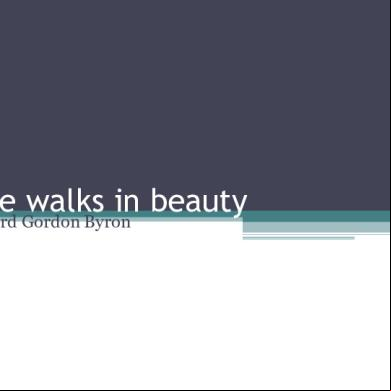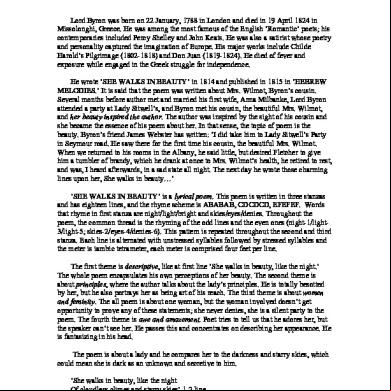She Walks In Beauty 2npi
This document was ed by and they confirmed that they have the permission to share it. If you are author or own the copyright of this book, please report to us by using this report form. Report l4457
Overview 6h3y3j
& View She Walks In Beauty as PDF for free.
More details h6z72
- Words: 782
- Pages: 23
She walks in beauty Lord Gordon Byron
Born in 22 January 1788, London Got the title “Lord” from his uncle. Belonged to the Romantic Era. Best-known works are Don Juan, She Walks in Beauty and Childe Harold's Pilgrimage . Developing a violent fever he died in 19 April 1824 (aged 36) in Greece.
She walks in beauty She walks in beauty, like the night that brow, Of cloudles climes and starry skies; And all that`s best of dark and bright that glow, Meet in her aspect and her eyes; spent, Thus mellowed to that tender light bellow, Which heaven to gaudy day denies. One shade the more, one ray the less, Had half impaired the nameless grace Which waves in every raven tress, Or softly lightens o`er her face; Where thoughts serenely soft express, How pure,how dear their dwelling place.
And on that cheek ,and o`er So soft,so calm, yet eloquent, The smiles that win, the tints But tell of days in goodnes A mind at peace with all A heart whose love is innocent!
• Was written in 1814, when Byron was 26 years old. • Was inspired by the poet`s first sight of his young cousin by marriage,Anne Wilmot. • The poem consists of three six-line stanzas. • The poem scheme rhyme is ABABAB,CDCDCD,EFEFEF. • The meter is also regular-iambic tetrameter,four iambs per line.
• Byron uses a great deal of imagery to describe this woman. • The poet does not identify her by name,indicate his relationship to her,or hint as to the occasion that brought them together. • On the surface it is a fairly conventional description of a beautiful woman,evidently someone to whom Byron is acquainted.
Stanza 1 • Lines 1-3
She walks in beauty,like the night Of cloudles climes and starry skies ; And all that`s best of dark and bright
-Byron turns “night” which usually a symbol of darkness and death,into something beautiful. -Uses alliteration to call attention to the light/dark images-cloudles climes-starry skies,day denies and her beauty. -Byron presents an ethereal portrait of the young woman in the first two stanzas by contrasting white with black and light with shadow in the same way that nature presents a portrait of the firmament—and the landscape below—on a cloudless starlit evening
• Lines 4-6
Meet in her aspect and her eyes ; Thus mellowed to that tender light Which heaven to gaudy day denies.
• “tender light”-is something you feel,light is something you see-he uses the two senses • Which heaven to gaudy day deniespersonification is used twice,heaven can`t deny anything and the day can`t be gaudy. • It is poem of polarities-light and dark,dark and bright • Metonymy, in which heaven is substituted for God or for the upper atmosphere
Stanza 2 • Lines 7-9
One shade the more, one ray the less, Had half impaired the nameless grace Which waves in every raven tress, • Metaphor comparing grace, a quality, to a perceivable phenomenon
• These cansel each other and really suggest that there is a balance to the dark light and really what beauty is about. • “raven tress” is a metaphor-this is unussual because at the time pale blonds were the standard f beauty.Byron states that the dark hair makes her face lighter.
• Lines 10-12
Or softly lightens o`er her face; Where thoughts serenely soft express, How pure,how dear their dwelling place • This outside beauty is a reflection of her inside beauty. • Personofies thoughts,they don`t speak,uses a metahpor for her mind. • Metaphor and personification comparing thoughts to people; metaphor and personification comparing the mind to a home (dwelling-place).
Stanza 3 • Lines 13-15
And on that cheek ,and o`er that brow, So soft,so calm, yet eloquent, The smiles that win, the tints that glow, • Metaphor and personification comparing the woman`s cheek and brow to persons who tell of days in goodness spent
• Lines 16-18
But tell of days in goodnes spent, A mind at peace with all bellow, A heart whose love is innocent! • These issues raise a concern that the woman seems so pure because she is so simple; she wears her thoughts directly on her face, and she shows no evidence of discrimination of better from worse. Her mind is “at peace with all below” (line 17), and she loves innocently. • . If she is beautiful like the night, perhaps her mind truly is like a sky without any clouds of trouble or confusion. In contrast, she has been able to spend her days in “goodness,” the tints in her face glowing like stars in the sky, small punctuations in a vast emptiness above.
Thank You!
Thank You!
Born in 22 January 1788, London Got the title “Lord” from his uncle. Belonged to the Romantic Era. Best-known works are Don Juan, She Walks in Beauty and Childe Harold's Pilgrimage . Developing a violent fever he died in 19 April 1824 (aged 36) in Greece.
She walks in beauty She walks in beauty, like the night that brow, Of cloudles climes and starry skies; And all that`s best of dark and bright that glow, Meet in her aspect and her eyes; spent, Thus mellowed to that tender light bellow, Which heaven to gaudy day denies. One shade the more, one ray the less, Had half impaired the nameless grace Which waves in every raven tress, Or softly lightens o`er her face; Where thoughts serenely soft express, How pure,how dear their dwelling place.
And on that cheek ,and o`er So soft,so calm, yet eloquent, The smiles that win, the tints But tell of days in goodnes A mind at peace with all A heart whose love is innocent!
• Was written in 1814, when Byron was 26 years old. • Was inspired by the poet`s first sight of his young cousin by marriage,Anne Wilmot. • The poem consists of three six-line stanzas. • The poem scheme rhyme is ABABAB,CDCDCD,EFEFEF. • The meter is also regular-iambic tetrameter,four iambs per line.
• Byron uses a great deal of imagery to describe this woman. • The poet does not identify her by name,indicate his relationship to her,or hint as to the occasion that brought them together. • On the surface it is a fairly conventional description of a beautiful woman,evidently someone to whom Byron is acquainted.
Stanza 1 • Lines 1-3
She walks in beauty,like the night Of cloudles climes and starry skies ; And all that`s best of dark and bright
-Byron turns “night” which usually a symbol of darkness and death,into something beautiful. -Uses alliteration to call attention to the light/dark images-cloudles climes-starry skies,day denies and her beauty. -Byron presents an ethereal portrait of the young woman in the first two stanzas by contrasting white with black and light with shadow in the same way that nature presents a portrait of the firmament—and the landscape below—on a cloudless starlit evening
• Lines 4-6
Meet in her aspect and her eyes ; Thus mellowed to that tender light Which heaven to gaudy day denies.
• “tender light”-is something you feel,light is something you see-he uses the two senses • Which heaven to gaudy day deniespersonification is used twice,heaven can`t deny anything and the day can`t be gaudy. • It is poem of polarities-light and dark,dark and bright • Metonymy, in which heaven is substituted for God or for the upper atmosphere
Stanza 2 • Lines 7-9
One shade the more, one ray the less, Had half impaired the nameless grace Which waves in every raven tress, • Metaphor comparing grace, a quality, to a perceivable phenomenon
• These cansel each other and really suggest that there is a balance to the dark light and really what beauty is about. • “raven tress” is a metaphor-this is unussual because at the time pale blonds were the standard f beauty.Byron states that the dark hair makes her face lighter.
• Lines 10-12
Or softly lightens o`er her face; Where thoughts serenely soft express, How pure,how dear their dwelling place • This outside beauty is a reflection of her inside beauty. • Personofies thoughts,they don`t speak,uses a metahpor for her mind. • Metaphor and personification comparing thoughts to people; metaphor and personification comparing the mind to a home (dwelling-place).
Stanza 3 • Lines 13-15
And on that cheek ,and o`er that brow, So soft,so calm, yet eloquent, The smiles that win, the tints that glow, • Metaphor and personification comparing the woman`s cheek and brow to persons who tell of days in goodness spent
• Lines 16-18
But tell of days in goodnes spent, A mind at peace with all bellow, A heart whose love is innocent! • These issues raise a concern that the woman seems so pure because she is so simple; she wears her thoughts directly on her face, and she shows no evidence of discrimination of better from worse. Her mind is “at peace with all below” (line 17), and she loves innocently. • . If she is beautiful like the night, perhaps her mind truly is like a sky without any clouds of trouble or confusion. In contrast, she has been able to spend her days in “goodness,” the tints in her face glowing like stars in the sky, small punctuations in a vast emptiness above.
Thank You!
Thank You!











